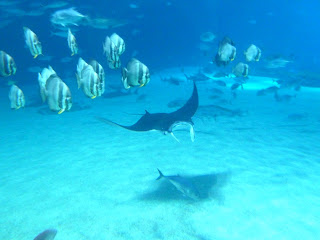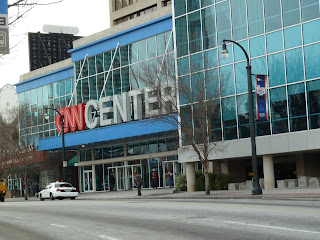What a jam-packed day this has been. I’ve discovered that with Atlanta, there is too much to do and too little time. I headed to my first destination in the center of Atlanta only to discover that within walking distance were my other stopping places. This was a bit of good luck because I much prefer walking as you end up with a richer experience. As I moved from place to place I saw a city worker riding a Segway. He stopped next to me and I couldn’t keep myself from asking the gentleman about it. I’ve been fascinated with the Segway since it was introduced several years ago, and if possible, will take a Segway tour of the city while I am here. The Segway rider told me that it is his job to ride around the downtown area looking for things that need to be repaired. He went on to say that if he had to walk, he wouldn’t get much done. In a car, he wouldn’t see problems like he can being out in the open. When he finds something that requires attention, he calls the city maintenance department. Would you like to ride a Segway?
The Segway driver told me these cargo containers hinder steering a bit.
My first stop for the day was the Georgia Aquarium. Atlanta is inland while both New Orleans and Miami are coastal cities. So, you might be wondering why I chose to visit the aquarium here and not the ones in the cities located on the water. The main reason is because the Georgia Aquarium is the largest indoor aquatic exhibit in the world. I had read about the Plexiglas walls that are two feet thick, and I wanted to see them for myself. The main tank holds 6.3 million gallons of water. If you used a garden hose, it would take 18 months to fill it.
The largest tank was built to house six full-grown whale sharks, fish that will grow to 40 feet long. These behemoths weigh tons and their mouths are four feet wide yet the diameter of their throats is the size of a quarter. Natives to warm waters near the equator, whale sharks are neither whale nor shark. They are called whale sharks because they are huge fish with dorsal fins. In fact, they are the largest fish in the ocean. If you wanted to move one of their fishes from its native habitat to an aquarium home in Atlanta, whom would you call? It seems your best bet would be UPS. Yes, it was UPS who transported the fish 8,000 miles, a trip lasting thirty hours. If you are like me, you are wondering how in the world they completed this job successfully. In one of the pictures below, you can see the container UPS used to move one of the fish.
This container transported one of the whale sharks to Atlanta.
This is a whale shark. It is difficult to photograph moving animals!
The animal in the center is a manta ray. They can grow large enough to overturn a small boat.
Mr. Manta Ray up close.
I'll bet you can guess what this guy is.
A whale shark
The Georgia Aquarium is divided into exhibit areas:
· Coldwater Quest—animal life from the coldest ocean areas
· River Scout—includes animals from the rivers of Africa, South America, Asia, and Georgia
· Georgia Explorer—a gallery filled with animals you can touch and a play area for children
· Ocean Voyager—the largest tank and home to giants of the sea including the only manta ray ever housed in an American aquarium
· Tropical Diver—living reef exhibit
Each exhibit was fascinating. I took almost 300 photographs, but sadly, most of them did not turn out well because of reflections (I did have the flash turned off). But some do provide a good illustration of what you can find at the Georgia Aquarium. In addition to the exhibits I saw a 3D cartoon movie about the ocean complete with water droplets splashed onto the heads of the audience.
If you read my blog about Miami, you will know this is the SECOND white alligator I've seen in my life, both within one week.
These bad boys are electric eels and can deliver 500 volts of electricity. Ouch!
Spare fingers, anyone? These piranhas have sharp teeth for biting.
Do you see that spiky little fellow? He is a sea urchin. I stepped on one once, purely by accident. I suggest you avoid them at all costs!
Don't you love how graceful sea anemones look? Compare that to the spiky sea urchin.
Japanese Spider Crabs
A penguin going for a swim
Beluga Whales
 |
| Various colored corals (several photos) |
 |
| Can you find the sea horse and the starfish? |
This picture and the next show jellyfish.
Venomous Lionfish
After leaving the aquarium I headed over the Centennial Olympic Park, a lovely spot created in time for the 1996 Olympics hosted by Atlanta. According to the website, the park “performs a dual mission: it serves as Georgia's lasting legacy of the Centennial Olympic Games and it anchors efforts to revitalize residential and commercial development in Georgia's capital city of Atlanta.” The Centennial Olympic Park is well known for its fountains. Five interlocking rings—the Olympics’ symbol- each contain dozens of sprinkler heads. At various times the “Fountain of Rings” exhibits synchronized water dances to familiar tunes complete with sound and lighting effects. Today, for the first time since the weather turned cold, the fountains were turned on because the weather was fairly warm. I watched as a spontaneous sideshow unfolded in front of me. It must be a tradition here because when the water was not spurting from the sprinkler heads, people would run into the rings. They would stay mostly dry as the water shot overhead. Others would try to run in and out of the rings, trying to time their escapes so that they would not get wet.
 |
| The entrance to Centennial Olympic Park |
Fountain of the Rings
 |
| Home of the Chick-fil-A Bowl |
ACC vs SEC
My last visit of the day was to a place with an easily recognizable logo, big red letters spelling out CNN. Ted Turner established Cable News Network 38 years ago. At the time, many predicted that a 24-hour news channel would not be successful. But Ted Turner’s gamble has turned into a global news organization with bureaus in a multitude of countries. CNN has bureaus in many countries including most of Europe, one in China, four in South America, and a handful in African countries. I was surprised to learn, however, that there is no CNN bureau in Canada, nor is there one in Australia. And since CNN began, it has saved a copy of every single news broadcast that it has made. Think what a treasure-trove this will be for historians 100 years from now.
The long white structure is a 196 foot escalator. It goes up eight stories, and is the world's longest free standing escalator. It is inside the CNN Center.
Flags from every country can be found in the CNN atrium.
This CNN vehicle was used during the first Gulf War.
After passing through a security check, I went on a tour of the CNN Atlanta headquarters. Unfortunately, taking photos was forbidden. I learned a lot about the technical aspects of running a television news channel, but what interested me most was how carefully the researchers have to fact check every bit of information before it is aired. Once the team of fact checkers has done its job, writers then create a script for the anchorperson to read on the air. Those who work in the newsroom are on call 24 hours a day, seven days a week, 365 days a year. During the aftermath of 9-11, the crew stayed in the locked-down building for several days. Beds were installed for short sleeping periods, but no one left the building.
As I finished up my tour of CNN, I noticed a sign on the wall: “We are what we air. We air what we are.” What do you think this means?
I’ll end with one more question. Who was Dr. John Pemberton, and what did he invent? Stay tuned to find out.
I’ll end with one more question. Who was Dr. John Pemberton, and what did he invent? Stay tuned to find out.
Dr. John Pemberton and his "pick-me-up"




































1 comment:
Dr. M,
I cannot tell you how much my husband and I are enjoying this trip with you. I am a faithful reader of Rachael's blog and she led us here. We're seeing places we will never see on our own and are learning so much from you.
Thank you.
Peggy
Post a Comment